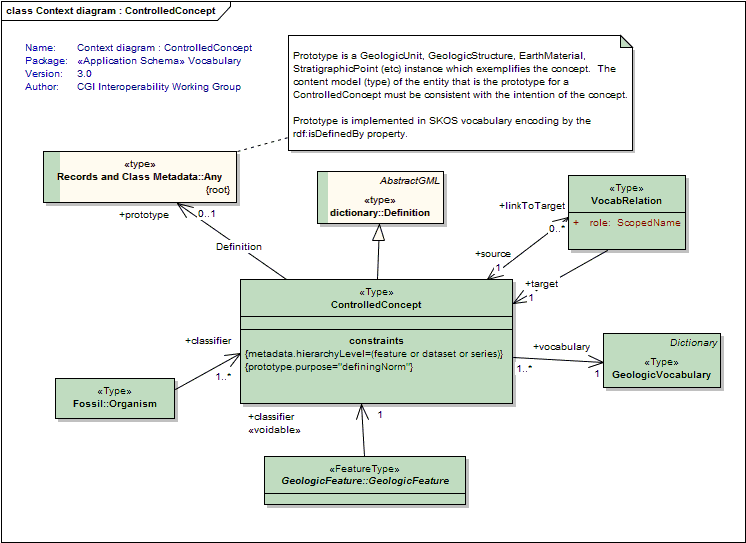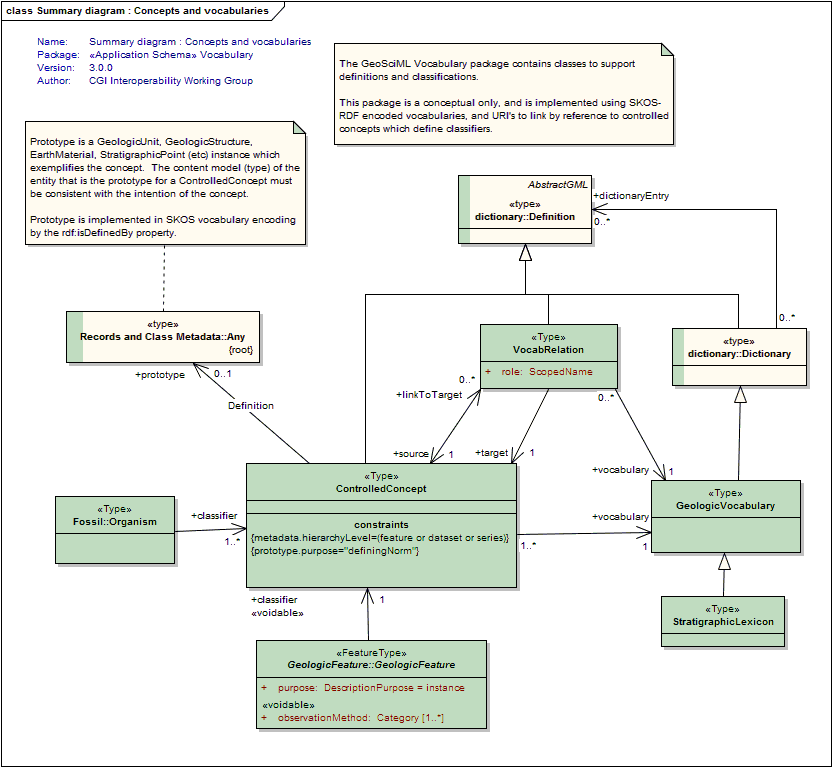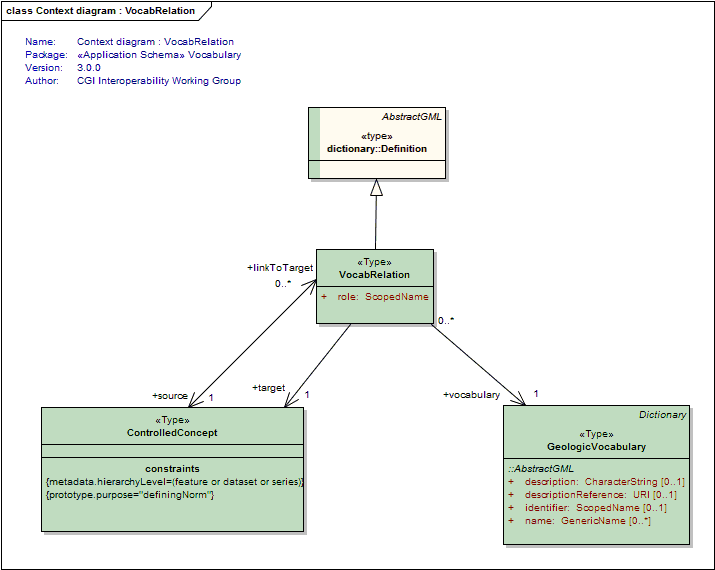Package GeoSciML/Vocabulary
The GeoSciML Vocabulary package contains classes to support definitions and classifications.
This package is a conceptual only, and is implemented using SKOS-RDF encoded vocabularies, and URI's to link by reference to controlled concepts which define classifiers.
Class Summary |
|
| <<Type>> Classes | |
ControlledConcept
<<Type>>
|
Element to represent a defined concept. A concept in the context of a GeologicVocabulary. A relationship class representing inclusion of an instance of a concept in a GeologicVocabulary. The GeologicConcept instance must have an associated definition (prototype 0..1), which may be text for human interpretation, or a formal description in the form of a geologic entity. * items in the classification framework * every GeologicUnit may be classified as being representative of a Controlled Concept. This may be a formal stratigraphic unit from a stratigraphic lexicon, or some generic mappable concept like 'alluvial fan deposit' or 'basaltic rock'. * a Controlled Concept instance mayt be associated with one special feature or object, which is the prototype or normative description meant to specify what the concept represents. |
GeologicVocabulary
<<Type>>
|
A collection of terms (ControlledConcepts) and their associated definitions and relationships between the terms, usually organized in some logical fashion such as in a hierarchy (geologic time, rocks, unconsolidated deposits...). An instance of a GeologicConcept may occur only once in a particular GeologicVocabulary. In GeoSciML this is normally identified using a URN in the "classifierScheme" branch of the CGI URN scheme, with the @codesSpace attribute set to "urn:ieft:rfc:2141". |
StratigraphicLexicon
<<Type>>
|
Geologic vocabulary that is a collection of ControlledConcepts that have (or could have...) GeologicFeature.GeologicUnit prototoype instances. |
VocabRelation
<<Type>>
|
Relationships between ControlledConcepts. Use to implement thesaurus type relationships like 'broader than', 'narrower than', 'related term', 'synonym' etc. role attribute specifies relationship from source to target, read 'source' 'role' 'target'. VocabRelation and some other components may be replaced by another mechanism (OWL, SKOS, RDF, etc) at some future date, according to maturity and adoption level of standard technologies |
Tagged Values |
||
| Tag | Value | Notes |
| gmlProfileSchema | #NOTES#Description: URL of the schema location of a GML profile (optional) | Description: URL of the schema location of a GML profile (optional) |
| owner | IUGS Commission for the Management and Application of Geoscience Information | |
| schemaLocation | ||
| targetNamespace | http://xmlns.geosciml.org/Vocabulary/3.0 | Default: FIXME Description: Target XML namespace of the application schema |
| version | 3.0.0 | Default: FIXME Description: Current version of the application schema |
| xmlns | gsmlv | Default: FIXME Description: Namespace prefix to be used as short form of the target namespace |
| xsdDocument | #NOTES#Default: FIXME Description: Name of an XML Schema document to create representing the content of this package | Default: FIXME Description: Name of an XML Schema document to create representing the content of this package |
| xsdEncodingRule | iso19136_2007_INSPIRE_Extensions | Values: iso19136_2007 | iso19139_2007 | iso19136_2007_INSPIRE_Extensions Default: iso19136_2007 Description: XML Schema encoding rule to apply |
UML Diagram: Context diagram : ControlledConcept

UML Diagram: Summary diagram : Concepts and vocabularies

UML Diagram: Context diagram : VocabRelation

UML Diagram: Context diagram : GeologicVocabulary

UML Diagram: Vocabulary package dependencies

UML Diagram: Context Diagram : StratigraphicLexicon

